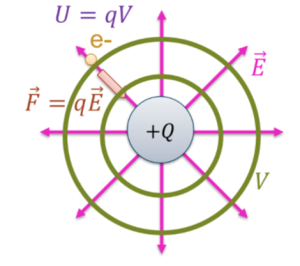17

Instructor’s Note
This chapter very strongly follows the ideas of a few distinct principles discussed in Unit I On-a-Page.

- All charges generate electric fields [latex]\vec{E}[/latex] (units N/C orV/m)
- For a point charge [latex]\vert \vec{E} \vert = \frac{1}{4 \pi \varepsilon_0} \frac{q}{r^2}[/latex]
- Point away from positive, towards negative
- These are real and exist regardless if something is there to feel or not!
- Put a charge in an electric field ⇒ it will feel a force [latex]\vec {F } =q \vec {E}[/latex]
- Can also think in terms of energy: All charges generate electric potentials [latex]V[/latex] (units Volts)
- For a point charge [latex]V = \frac{1}{4 \pi \varepsilon_0} \frac{q}{r}[/latex]
- Exists if something is there to feel or not!
- Put a charge in a potential it has a potential energy [latex]U = qV[/latex]
- Electric potentials and electric fields are two sides of the same coin
- Just like in P131: Can think of forces or energy
- [latex]\vec{E}[/latex] points ‘down the potential hill’
- [latex]\vec{E} = - \frac{\Delta V} {\Delta x}[/latex]
A fundamental relationship that describes how the Universe works. These are the fundamental truths of Nature. When writing a principle as an equation, the "=" is translated as "causes." For example, Newton's 2nd Law, F = ma, a force F causes an object m to accelerate (change its speed or direction) a. These principles are where we begin our analyses.

